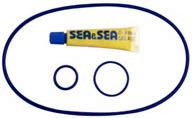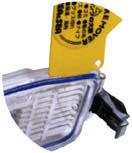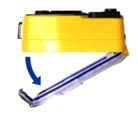Basic Maintenance
Underwater photographic equipment requires special care and maintenance. Your equipment has been designed to be submerged. It has been constructed to seal against water; that means it is watertight. The internal electronic mechanisms that drive the system are protected only if you protect the components that keep the water out.
Your system is vulnerable to a host of natural enemies. Here are the things that can harm your equipment:
- Salt
- Sun
- Dirt
- A bump, bang, drop or jolt
- Improper storage
- Neglect
- Improper repair
A maintenance regimen is essential. You've made a considerable investment in your equipment. Treat it properly and it will perform for you for a very long time. Neglect it and it will need costly repairs or, even worse, replacement.
The first thing you do after a dive is rinse your system in fresh water. Salt is your system's number one enemy. Salt water can dry and form crystals within 10 minutes after you surface. Submerge the system and let it soak for at least 30 minutes. While the system is soaking, agitate gently and work all the controls at least once. This will help flush out any salt residue.
Do not rinse your system with a hose. The high pressure may actually force salt crystals and sand into crevices. Lay the system on a clean towel and let it air dry; this allows water in inaccessible areas to evaporate. Then, using a clean, dry cloth, wipe excess moisture from the body, ports, levers, connectors, and so on. Do not wipe the lenses. Only lens tissues or photographic lens cloths should be used on lenses.
O-RING
BASICS
 O-rings are the most important components of your
underwater camera system. If the O-ring is lubricated, it will be elastic enough
to shape itself uniformly around the channel. If it is dry, there will be too
much friction to allow it to reshape itself uniformly. It will not safeguard
against flooding.
O-rings are the most important components of your
underwater camera system. If the O-ring is lubricated, it will be elastic enough
to shape itself uniformly around the channel. If it is dry, there will be too
much friction to allow it to reshape itself uniformly. It will not safeguard
against flooding.
Every time you open the camera to change film, examine the O-ring and service if necessary.
- Always clean and lubricate after every diving day.
- When in doubt about the sealing capability of an O-ring, always discard and replace.
- Never use a sharp or pointed object to remove an O-ring! Use Sea & Sea's O-ring remover tool.
- Don't overgrease! Too much grease attracts debris that will disrupt the seal and cause flooding. Silicone grease is not a sealant; it only protects the O-ring from abrasion. A perfectly greased O-ring looks moist and shiny.
ALWAYS
- Always soak the camera system in fresh water
after diving.
- Always dry the system thoroughly before disassembling.
- Always open the camera with the back cover facing
downward so that trapped water will fall away from the interior.
- Always open underwater photo equipment in a
dry environment. Avoid opening your system on the beach or aboard a boat where
it may be exposed to spray or sand.
- Always check the batteries before diving. Make
sure they are fresh.
- Always check that camera or housing is securely
sealed before entering the water.
- Always check camera and strobe for loose screws
before diving.
- Always take your time when caring for your photo
equipment. Haste causes flooding!
- Always read the care, maintenance and storage instructions in your user's manual. Read and heed!
NEVER
- Never allow salt water to dry on your system.
Salt deposits wreak havoc with photo equipment!
- Never pry or force moving parts. Mechanical
parts should move freely.
- Never leave home without a tool kit, fresh batteries,
and spare O-rings.
- Never use alcohol, cleaning solvents, or abrasives
to clean housing, camera, lenses or strobe.
- Never take a system from an air-conditioned
environment directly into the sun. Allow the system to warm up slowly so that
condensation will not form inside the viewfinder and lenses.
- Never leave the camera system exposed to direct
sunlight. Excessive heat can melt glues and warp plastic parts.
- Never jump into the water with a camera system
in your hands. Sudden impact can jar a lens or fitting loose and break the
watertight seal. Have someone hand it down to you.
- Never use a system that does not pass all pre-dive checks. If you have any doubts about the watertight integrity of the system, bring it to an authorized repair facility for examination.
 |
Before using your equipment, carefully inspect all the O-rings for salt, dust, sand, hair, cracks, nicks and any debris or damage. If an O-ring is dirty, clean it. If it is damaged, replace it with a new one. | |
|
Never use a sharp or pointed object to remove an O-ring from its channel. Never pull, twist, stretch or bend an O-ring. Abusive handling can damage the O-ring and void its sealing integrity.
|
 |
|
 |
To lubricate an O-ring, apply a dab of silicone grease to your fingertip, then draw the O-ring through your fingers till it is evenly coated. Use the grease sparingly. Too much grease attracts dust and debris. | |
|
Always open the back door on your camera with the lid facing down. In this position any trapped water will fall out and away from the interior. Open all O-ring-sealed equipment in this position.
|
 |